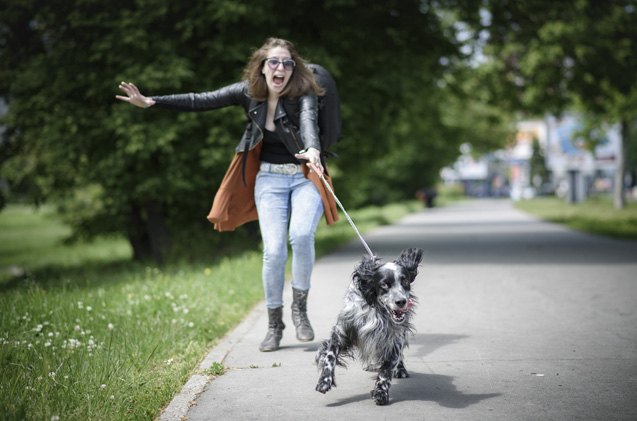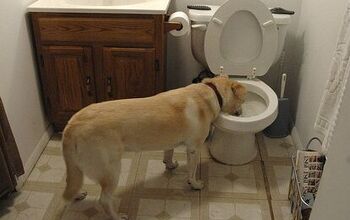How To Stop Your Dog From Pulling During Walks

It’s no wonder that leash walking problems are the number one complaint I hear from my dog training clients. To a dog, leashes are completely unnatural and unnecessary. Dogs are designed to wander in this-or-that direction, following a scent or investigating things in their environment. A six-foot leash just can’t allow such freedom. But since leashes are necessary for safety and required by law, we have to teach dogs how to walk politely while tethered to you.
Why Dogs Pull
There are numerous reasons why dogs pull. Hint: none of them have to do with dominance. Do any of these reasons apply to your pup?
- Your equipment. Dogs on retractable leashes learn to ignore tension on the leash, as there is always tension. Then, ouch!, they get yanked back when the leash reaches its limit. Additionally, dogs don’t seem to mind pulling even when the collar is cutting off the air supply. If your dog is a puller, put these tools to the side for now and read on.
- Your pace. Even small dogs may walk faster than the typical human. They need to be taught how to slow the pace, but also given opportunities to run and wander safely off-leash.
- Distractions. Your dog might not even notice you’re there, and as a result, you get dragged towards more interesting things: a smelly tree stump, other dogs, or a chipmunk’s hiding place. Can you blame him? A little training can teach him how fun it is to focus on you instead of that stinky fire hydrant.
- Lack of training. Since leash walking doesn’t come naturally, you’ll have to make a conscious effort to teach it. (Don’t worry, it’s actually fun!)
- Excessive energy. If your dog is high octane, it’s not realistic to think he’ll walk next to you. Training can only work if he’s calm enough to think clearly, so make sure leashed walks are not his only source of activity.
Pulling Solutions
There is no one-size-fits-all solution to stopping pulling. The following suggestions are tried-and-true and totally safe for your dog.
- Equipment. Certain pain-free equipment can reduce how intensely your dog pulls. Front-clip harnesses are safe and effective for dogs of all body types. (Extremely short dogs may get tangled, however.) These harnesses work by stopping your dog’s forward motion when he reaches the end of the leash, so he can’t drag you like a sled dog. Head collars are another choice. I find them more effective than front-clip harnesses, but occasionally dogs find the strap over the muzzle annoying. Avoid choke or prong collars, as they rely on pain.
- Dog pulls, you stop. While on walks, the moment your dog starts to pull, you will stop. As soon as he comes back towards you, even an inch, you can proceed walking. He will learn that tension on the leash leads to stopping, but loose leash walking means he can keep moving forward. This technique requires patience and consistency but pays off in the long run.
- Reward for attention. Your dog may have forgotten you’re on the walk with him. So remind him! Whenever he looks up at you, even for a split second, tell him “good dog!” and reward with a treat. Suddenly you’re not so forgettable anymore, and he will start to check in with you more often. More check-ins mean less pulling ahead.
- Practice parkour. Dog parkour, sometimes called “urban agility,” teaches your dog to do fun and simple tricks or exercises using his environment. Since you teach him the exercises, parkour allows you to communicate and bond with your pup in a carefree way. (Plus, it looks cool.) Check out alldogsparkour.com for inspiration.
- Provide playtime. Since leashed walks should be a time for you and your dog to interact, he should not be playing with other dogs while on leash. If he loves to romp with other dogs, make sure he has the appropriate outlet for this playful energy on a regular basis. Look for a dog park, a reputable daycare facility, or playdates with friends’ dogs. By separating playtime and walk-time, he can get the most out of both.
Teaching your dog to walk politely on leash takes practice, but a little effort goes a long way. You’ll find walks become more enjoyable, while your dog will learn how cool it is to stay by your side.

Kate Naito, CPDT-KA, is a dog trainer at Doggie Academy in Brooklyn, NY, and author of the training book, "BKLN Manners." She draws upon her experience as an educator and dog trainer to apply positive training techniques to a challenging urban environment. Kate is a rescue advocate drawn to special-needs dogs and currently has two Chihuahua mixes, Batman and Beans.
More by Kate Naito























